Spider Collector's Journal (28th page: 2018) Copyright © 2018 by Rod Crawford
Here's the 28th page of narratives of fun (and not so fun) trips to collect spiders for research at the Burke Museum, some accompanied by capable field volunteers: Laurel Ramseyer and new recruits. Most also appeared in Scarabogram, newsletter of "Scarabs: The Bug Society." Dates of field trips head each paragraph. Maps showing the location of sites within Washington state follow the grid system outlined in the Washington Spider Checklist. RETURN TO INDEX
Where you see this button ![]() in a
field trip account, click it to get a page of collecting site photos!
in a
field trip account, click it to get a page of collecting site photos!
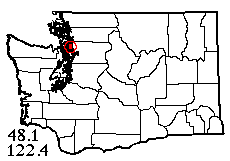 |
![]() 14 I 2018: On Saturday I happened to look outside and saw blue sky! So I checked the forecast, found amazing warmth and sun predicted for Sunday, and on the spur of the moment set up a field trip with Laurel. We headed for Elger Bay Preserve on Camano Island, one of the shortest trips remaining in my trip plan pile. As we approached, it became obvious that the ground and vegetation were still very wet despite the warm sunshine, so we decided to start at adjacent Elger Bay Elementary School, which Laurel hoped would have a full slate of house spiders on the building. Her hopes were fully realized, the building exterior, fences, etc. producing no less than 13 spider species! Meanwhile, I had to pick and choose conifer foliage around the school clearing to keep from getting my net wet and useless. The conifer sample was pitiful, only 3 species, but including the day's best catch, Meriola californica. A pile of ornamental-tree leaves against a fence, semi-dry by now, yielded 4 litter species. And now it was time to brave the trail network in the nature preserve.
14 I 2018: On Saturday I happened to look outside and saw blue sky! So I checked the forecast, found amazing warmth and sun predicted for Sunday, and on the spur of the moment set up a field trip with Laurel. We headed for Elger Bay Preserve on Camano Island, one of the shortest trips remaining in my trip plan pile. As we approached, it became obvious that the ground and vegetation were still very wet despite the warm sunshine, so we decided to start at adjacent Elger Bay Elementary School, which Laurel hoped would have a full slate of house spiders on the building. Her hopes were fully realized, the building exterior, fences, etc. producing no less than 13 spider species! Meanwhile, I had to pick and choose conifer foliage around the school clearing to keep from getting my net wet and useless. The conifer sample was pitiful, only 3 species, but including the day's best catch, Meriola californica. A pile of ornamental-tree leaves against a fence, semi-dry by now, yielded 4 litter species. And now it was time to brave the trail network in the nature preserve.
Even now in mid-afternoon, most forest habitats were still wet. But some of the fern understory in a conifer stand was merely damp, so I worked on that, adding 3 species. Next, I gathered a big bagfull of still-wet maple litter which I had to haul back to the school to sift (every place in the woods I could have laid out the sifting cloth was still soaked). Results of this sifting looked very promising, with several mature linyphiid microspiders. Alas, every one of them was one species, Wubana pacifica (usually not that common). But in all, this sifting added another 4 species to the total. Finally, I went to the preserve's impressive "Beaver Marsh" to sweep some wetland species, figuring it didn't matter now if my net got wet. Meanwhile, Laurel beat some finally-dried salal near the school. I added 5 more species and she added 3, for a good total of 34-36 species, surprising when the most reliable habitats were lackluster. And nothing went wrong other than wet habitats.
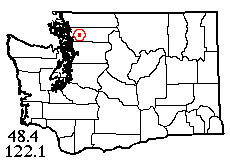 |
![]() 7 III 2018: After wet, cold weeks, a short dry spell with highs over 50°F was predicted. Well, at least the dry part held good but when Laurel and I got to our site (a working forest tract south of the Skagit River and west of Gilligan Creek), it definitely wasn't that warm. At our first site, a private clearcut mostly covered with dense 2-meter tall alder (some cottonwood & maple too), I set out to beat conifer foliage which got me only 2 species in the end. Some ferns on a bank produced one specimen, but a good one: the second Washington record of European pirate spider Ero tuberculata. Laurel found some more productive ferns, adding 4 more species. The whole clearcut was covered by leaf litter warm enough to sift, but it only got me 2 more species. So, we headed back down the road looking for other habitats. Soon, we spotted a gated side road leading into the Cultus Mountain Watershed, with foot access welcome! A fairly vigorous hike later, we were at another clearcut quite similar to the first one, but this one had a growth of tall grass; Laurel's sweeping added 2 species to the list. Laurel found some open western hemlock cones here (bigger cones were hard to find, and closed) to tap later. Only 12 species for the day so far. I didn't know it at the time, but if we'd taken a left turn in our hike we could have seen Gilligan Creek Falls, probably a better habitat!
7 III 2018: After wet, cold weeks, a short dry spell with highs over 50°F was predicted. Well, at least the dry part held good but when Laurel and I got to our site (a working forest tract south of the Skagit River and west of Gilligan Creek), it definitely wasn't that warm. At our first site, a private clearcut mostly covered with dense 2-meter tall alder (some cottonwood & maple too), I set out to beat conifer foliage which got me only 2 species in the end. Some ferns on a bank produced one specimen, but a good one: the second Washington record of European pirate spider Ero tuberculata. Laurel found some more productive ferns, adding 4 more species. The whole clearcut was covered by leaf litter warm enough to sift, but it only got me 2 more species. So, we headed back down the road looking for other habitats. Soon, we spotted a gated side road leading into the Cultus Mountain Watershed, with foot access welcome! A fairly vigorous hike later, we were at another clearcut quite similar to the first one, but this one had a growth of tall grass; Laurel's sweeping added 2 species to the list. Laurel found some open western hemlock cones here (bigger cones were hard to find, and closed) to tap later. Only 12 species for the day so far. I didn't know it at the time, but if we'd taken a left turn in our hike we could have seen Gilligan Creek Falls, probably a better habitat!
Back near the bottom of the Cultus Mountain hike, we stopped by a nameless brook for some forest sifting and sweeping. The leaf litter here was just a little too cold; I sifted a lot of it for only 4 spider species. Laurel tapped those hemlock cones, and was skunked — a stink bug in my sift sample provided an appropriate skunky odor. Next, Laurel decided to sift some moss and did significantly better, adding 7 more species. The fern-understory beat added some good stuff too. In all, we ended the day with a solid but not exceptional 25-species sample. It's thanks to Laurel that we did succeed in getting a full sample; had I been alone, it would have been "missed it by that much!" A final stop at a gravel pit off East Gilligan Creek Road gave me some rocks to turn over, but no spiders under them.
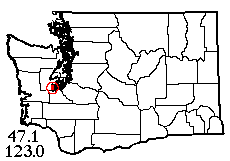 |
![]() 11 III 2018: A few days after our unexpectedly chilly previous trip, the forecast called for unseasonable highs in the 60s — correctly this time, so we couldn't resist another excursion. A coin toss sent us southward to Little Skookum Inlet (a remote arm of Puget Sound between Olympia and Shelton) where Port Blakely Tree Farms, the local landowner, has developed a public, but unnamed, shore access site that's essentially a park. Arrived at the access road gate, wet-looking dew sent us to a nearby dry clearcut for a little initial sampling. An hour or so later we were down by the shore, using a picnic table for its highest purpose (sifting leaf litter) while several other people tried salt water fishing, apparently with little success.
11 III 2018: A few days after our unexpectedly chilly previous trip, the forecast called for unseasonable highs in the 60s — correctly this time, so we couldn't resist another excursion. A coin toss sent us southward to Little Skookum Inlet (a remote arm of Puget Sound between Olympia and Shelton) where Port Blakely Tree Farms, the local landowner, has developed a public, but unnamed, shore access site that's essentially a park. Arrived at the access road gate, wet-looking dew sent us to a nearby dry clearcut for a little initial sampling. An hour or so later we were down by the shore, using a picnic table for its highest purpose (sifting leaf litter) while several other people tried salt water fishing, apparently with little success.
Although the litter spiders were a bit sparse, they were diverse with 11-12 species. I swept 2 species from the beach meadow and sifted 2 others (the day's coolest) from beach wrack. Laurel and I got about 5 from Douglas-fir foliage over the upper beach. An excellent moss sift added another 12; fern and salal understory beats were similarly productive. Tapping fully 150 Douglas-fir cones (now finally getting open) in her net got Laurel only 5 species, 3 of them mature. None of the many active wolf spiders was mature, but we still got 47-49 species for the day, nearly double our catch from chilly Cultus Mountain. Laurel also spotted the uncommon giant beach isopod Ligia pallasii (see album) but didn't know I would have liked a specimen…
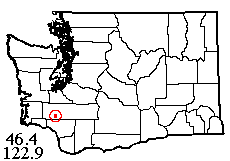 |
![]() 31 III 2018: Laurel's availabilty didn't coincide with another one-day weather window, so I called on a field driver applicant from long ago, Kent Karnofski, who amazingly was available. We headed south to an area near Vader (Lewis County) I'd hoped to sample last year when a trip was cut short by rain, starting at Little Falls Cemetery, a large well-kept site (but lacking visitors today, except for us). The farther south we drove, the thinner the clouds. By the time we'd been sifting litter in a graveless quarter of the cemetery for 90 minutes or so, it was a beautiful clear day, and almost warm. An alder-maple zone along one edge of the lawn gave us 11 species from leaf litter including a female Ozyptila that at first glance doesn't seem to be any known species. Moss-sifting produced even more spiders, with 6 species that were different.
31 III 2018: Laurel's availabilty didn't coincide with another one-day weather window, so I called on a field driver applicant from long ago, Kent Karnofski, who amazingly was available. We headed south to an area near Vader (Lewis County) I'd hoped to sample last year when a trip was cut short by rain, starting at Little Falls Cemetery, a large well-kept site (but lacking visitors today, except for us). The farther south we drove, the thinner the clouds. By the time we'd been sifting litter in a graveless quarter of the cemetery for 90 minutes or so, it was a beautiful clear day, and almost warm. An alder-maple zone along one edge of the lawn gave us 11 species from leaf litter including a female Ozyptila that at first glance doesn't seem to be any known species. Moss-sifting produced even more spiders, with 6 species that were different.
Along the next edge of the lawn were several big Douglas-firs; beating the foliage added 4 species. At ground level, there was much sunlit salal around the edge, adding a further 4. Pardosa vancouveri wolf spiders, now beginning to mature, had become active in taller grass around the edges, also sunning on monuments. Finally, a service building yielded one orbweaver, a mature female Metellina mimetoides, our 29th species.
Now we crossed the highway and entered a tract of Sierra Pacific timberland. A short walk up the logging road brought us to a clearing apparently used to store road gravel, culverts etc., where we hoped to get a better conifer foliage sample at the edge. No such luck, the tree-branch spiders were even less diverse here, but the sample did include a nice, tiny Ceraticelus fissiceps. Across the clearing was what appeared to be a pile of wood chunks, which I hoped would have nice spiders under them; oops, it was really fragments of old rusty metal culverts! But the adjacent forest had a rich understory of ferns and Oregon-grape. Kent couldn't quite get the hang of sweeping spiders from this but I got 7 species including the rare kleptoparasite Rhomphaea fictilium. For a final addition to the species total I hoped to get a grass-sweep sample at a powerline clearing a half-mile back toward Vader. At this season, there was a lot more stiff shrub foliage in the clearing than grass, but I still added 4 species while Kent continued to have a "sweep deficit." End total, a very good 40 species.
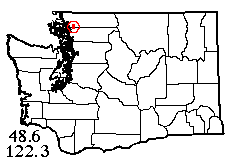 |
![]() 24 IV 2018: I seemed pretty much recovered from an unpleasant illness last week, so Laurel and I headed for an obscure trail just east of Alger, northern Skagit County. A segment of the little-publicized Pacific NW Trail, this lowland hike partly in working forest, partly in public land, starts at a gate beside Alger-Cain Lake Road near the bridge over Silver Creek. 0.4 miles up the trail (in pleasant spring weather), we came to a new side road, uphill to a brand-new clearcut on private land. Adjacent to the clearcut was some maple woodland and good-looking fern understory, so we decided to try for a sample here. Sifting maple litter, I thought I was getting about 8 species (actually 5). Moss was better; with me sifting moss on maples and Laurel sifting moss on firs, we got 12 species. In the process, Laurel found that the moss on trunks had some of the Ozyptila crab spiders she was interested in, while the moss on limbs had none (spiders otherwise similar).
24 IV 2018: I seemed pretty much recovered from an unpleasant illness last week, so Laurel and I headed for an obscure trail just east of Alger, northern Skagit County. A segment of the little-publicized Pacific NW Trail, this lowland hike partly in working forest, partly in public land, starts at a gate beside Alger-Cain Lake Road near the bridge over Silver Creek. 0.4 miles up the trail (in pleasant spring weather), we came to a new side road, uphill to a brand-new clearcut on private land. Adjacent to the clearcut was some maple woodland and good-looking fern understory, so we decided to try for a sample here. Sifting maple litter, I thought I was getting about 8 species (actually 5). Moss was better; with me sifting moss on maples and Laurel sifting moss on firs, we got 12 species. In the process, Laurel found that the moss on trunks had some of the Ozyptila crab spiders she was interested in, while the moss on limbs had none (spiders otherwise similar).
We both tried sweeping the fern understory, adding 3 species. A small trailside clearing (with a pond) added only 2, and none of the 3 species from trailside fir foliage added to the list. Moreover, here in peak wolf spider season I couldn't find a single one, in streamside or trailside grass or the clearcut!
Heading back down the trail, Laurel stopped to tap 50 Douglas-fir cones which only added 1 species. At this point, my convalescent body decided to give out; I totally ran out of steam in mid-afternoon. Back by the road, Laurel did some work around the bridge over Silver Creek, adding very little to the list, but getting the coolest specimens of the trip, a couple of mature male Dipoena lana (see album). Total for the trip, 26 species. At least we didn't waste our time, but it's unusual for a site that looked so good in advance to prove mediocre.
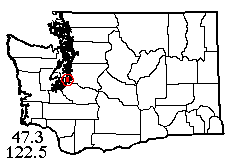 |
![]() 27 IV 2018: For some time, Laurel and I had been planning to participate in the Point Defiance Park BioBlitz, hoping against hope for good weather. Well, we got what we wanted: at least Friday, first day of the 2-day event, was dry, though mostly cloudy. Our object was to record as many spider and related group species as possible from the 760-acre park, mostly natural second-growth forest, in one day; after which the organizers would feed us! We arrived on time, checked in at the park's Environmental Learning Center with organizer Craig Standridge, then headed (with a high-schooler for data entry) to our main site, Owen Beach, selected because it had good prospects of maple litter, moss, salal, fern and beach habitats. This time my advance-scoping worked out well; also, I stayed vigorous through the day (perhaps because I filled my water bottle with tea).
27 IV 2018: For some time, Laurel and I had been planning to participate in the Point Defiance Park BioBlitz, hoping against hope for good weather. Well, we got what we wanted: at least Friday, first day of the 2-day event, was dry, though mostly cloudy. Our object was to record as many spider and related group species as possible from the 760-acre park, mostly natural second-growth forest, in one day; after which the organizers would feed us! We arrived on time, checked in at the park's Environmental Learning Center with organizer Craig Standridge, then headed (with a high-schooler for data entry) to our main site, Owen Beach, selected because it had good prospects of maple litter, moss, salal, fern and beach habitats. This time my advance-scoping worked out well; also, I stayed vigorous through the day (perhaps because I filled my water bottle with tea).
Maple litter sifting (on a nice stone picnic table) produced a solid 10 mature species, plus a few others taken as juveniles and several non-spider species. Laurel and I each found a small amount of moss to sift, between us adding 4 species. Salal beating was very productive with 13 species, and ferns added a few more. Laurel found some halfway decent conifer foliage on the beach and also took several species from buildings. The only habitat that didn't pan out was the beach itself; no jumping spiders or other typical beach denizens appeared. Some beach tourists appeared, not too many on this cloudy weekday, but only 2 groups asked any questions.
I was hoping to round out the day with some grassland habitat, but all Craig knew of was occupied by the zoo's muskox exhibit! Fortunately our afternoon student volunteer was able to guide us to a grassy meadow that was part of the Northwest Native Plant Garden (part of the park grounds). Laurel and I started at opposite ends, but she picked the wet end! My end of the meadow was fairly dry, and although not extremely rich, the sweep sample gave me 4 more species. Adjacent to the meadow were a number of planted grand-fir and mountain hemlock trees, which gave an excellent upland conifer foliage sample. Meanwhile, Laurel had tapped 100 Douglas-fir cones near the meadow and 100 non-native pine cones by the zoo's parking lot, adding respectively 1 and 2 species to the total. I finished the day by sifting some maple litter wind-deposited against the meadow's fence, adding 3 species not in the other litter. Our total: 45 spider species confirmed plus 8 more taken only as juveniles whose species ID's are probable — plus 3 harvestmen, 3 isopods, 1 each centipede & millipede. And the taco-bar dinner was worth the wait!
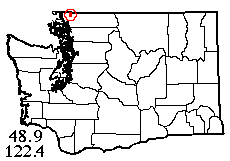 |
![]() 2 V 2018: Last September 28, Laurel visited the small city of Lynden, almost on the Canadian border, to take pine-cone spider samples. Her sites appeared promising for general collecting, so we made a return visit in the spring. Unfortunately, Laurel's first site (a field next to a mall) has, in the intervening 7 months, become a construction site! But I'd selected an alternate, nearby Northwest Washington Fairgrounds, now in its off-season. We stopped in a sort of storage area behind the main fair buildings, where Laurel surveyed buildings and structures while I collected the trip's one wolf spider and sifted a pile of oak litter, accumulated in a fence corner. The litter fauna appeared fairly rich, but in the end consisted mainly of introduced Poeciloneta globosa and Bathyphantes concolor, neither one at all common in other parts of the state. Also at this site were range extensions for two other non-native species recently discovered in Washington by Laurel: the dictynid Lathys humilis and jumping spider Pseudeuophrys lanigera! Now with 15 species in the bag, we moved a block west to a natural grass marsh on Fishtrap Creek, adjacent to the fairgrounds. Here, after difficult access to the site, we swept 4 native species from the grass, including uncommon Pachygnatha and Dismodicus species, and Laurel got three non-native species from a big handfull of moss.
2 V 2018: Last September 28, Laurel visited the small city of Lynden, almost on the Canadian border, to take pine-cone spider samples. Her sites appeared promising for general collecting, so we made a return visit in the spring. Unfortunately, Laurel's first site (a field next to a mall) has, in the intervening 7 months, become a construction site! But I'd selected an alternate, nearby Northwest Washington Fairgrounds, now in its off-season. We stopped in a sort of storage area behind the main fair buildings, where Laurel surveyed buildings and structures while I collected the trip's one wolf spider and sifted a pile of oak litter, accumulated in a fence corner. The litter fauna appeared fairly rich, but in the end consisted mainly of introduced Poeciloneta globosa and Bathyphantes concolor, neither one at all common in other parts of the state. Also at this site were range extensions for two other non-native species recently discovered in Washington by Laurel: the dictynid Lathys humilis and jumping spider Pseudeuophrys lanigera! Now with 15 species in the bag, we moved a block west to a natural grass marsh on Fishtrap Creek, adjacent to the fairgrounds. Here, after difficult access to the site, we swept 4 native species from the grass, including uncommon Pachygnatha and Dismodicus species, and Laurel got three non-native species from a big handfull of moss.
Our next stop was Bender Fields Park in northeast Lynden (about 3 miles from Canada) where Laurel had made a concerted (but fruitless) effort to find introduced crab spider Ozyptila praticola in Douglas-fir cones in September. Since then, they have moved in big-time; she found little else in the cones. I beat 9 species from conifer foliage here, one additional from a juniper hedge, and only 3 species (all introduced) from creekside leaf litter. Mostly sports fields, this park's narrow strip of habitat was well worth a visit!
Our final Lynden site was an inconspicuous side road where Hannegan Road crosses the Nooksack River. It leads to what might once have been a public boat launch, now well-overgrown but giving access to a 500-foot wide strip of cottonwood-dominated riparian woodland. Here, Laurel sifted some scanty moss on the trees and got lots more Ozyptila praticola. I added some more species from rich grassy understory, and we ended the day with a solid 33-species sample.
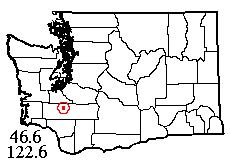 |
![]() 7 V 2018: Today's weather forecast looked a little more favorable for south of Olympia, so Laurel and I headed for an area east of the freeway in Lewis County, on Centralia-Alpha Road. Our first site, in a working forest area, was in a 2006 clearcut, gated by an owner who as usual, had no problem with responsible public access. (We talked to him later and confirmed that). This seemingly average site had really excellent spider diversity! Our first problem was that all ground-level foliage was sopping wet, apparently from a short early morning shower. Luckily, the numerous young Douglas-firs were mostly already dry, and their foliage produced an excellent 13 species. At the edge of a nearby alder stand I gathered 2 partial bags-full of the sparse litter and added 7 more good species. Now the sun broke through the overcast and Laurel collected 2 wolf spider species on roadside mud. Next, she sifted some sparse moss on alder and young conifer trunks for no less than 10 species. By now, the grass exposed to sunlight was dry enough to sweep for another 4 species. Just from this clearcut in half a day, we already had 35 species!
7 V 2018: Today's weather forecast looked a little more favorable for south of Olympia, so Laurel and I headed for an area east of the freeway in Lewis County, on Centralia-Alpha Road. Our first site, in a working forest area, was in a 2006 clearcut, gated by an owner who as usual, had no problem with responsible public access. (We talked to him later and confirmed that). This seemingly average site had really excellent spider diversity! Our first problem was that all ground-level foliage was sopping wet, apparently from a short early morning shower. Luckily, the numerous young Douglas-firs were mostly already dry, and their foliage produced an excellent 13 species. At the edge of a nearby alder stand I gathered 2 partial bags-full of the sparse litter and added 7 more good species. Now the sun broke through the overcast and Laurel collected 2 wolf spider species on roadside mud. Next, she sifted some sparse moss on alder and young conifer trunks for no less than 10 species. By now, the grass exposed to sunlight was dry enough to sweep for another 4 species. Just from this clearcut in half a day, we already had 35 species!
Next, we went a short distance down the road to a more-mature timber stand, mostly western hemlock, some of which were exceptionally moss-draped. Laurel sifting this moss added 5 more species, while I got 2 more from the fern understory. Finally we stopped at the Alpha Cemetery; our short time there didn't add much to the list (the grounds were too clean and well-groomed to have many spiders), but Laurel tapping only 25 pine cones from a tree outside the fence got yet another range extension of recently-introduced Zodarion rubidum.
Near our freeway exit, Laurel had spotted some more (planted) pine trees and wanted to tap their cones too. They turned out to be shore pines, Pinus contorta, whose small cones had almost no spiders. The one specimen, a dictynid, might have been interesting had it only been mature. But our site near Alpha produced 47 species in all, and some previous records from farm fields bring it up to 50!
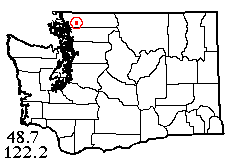 |
![]() 14 V 2018: Looking for new field sites in lowland Whatcom County, I found two in the lower valley of the south Fork Nooksack river, between two ridges of foothills east of Bellingham. First, Laurel and I took a rather circuitous route to Van Zandt Cemetery, which is quite small (3/4 of an acre) but full of interest. Surrounded by farms, this cemetery has good Doug-fir trees (one of which dropped cones for Laurel to tap), sheds with lots of house spiders, a chain-link fence with more spiders, and a rich grassy verge outside the fence. As two unusual horses watched from across the road, we collected 18 spider species from this little area; by far the best was a male of the ant-mimic jumping spider genus Synageles, found by Laurel on the fence. I would expect it to be S. occidentalis, taken twice before in the state, but the palp isn't a really good match for any known species. Needs more study at a later date!
14 V 2018: Looking for new field sites in lowland Whatcom County, I found two in the lower valley of the south Fork Nooksack river, between two ridges of foothills east of Bellingham. First, Laurel and I took a rather circuitous route to Van Zandt Cemetery, which is quite small (3/4 of an acre) but full of interest. Surrounded by farms, this cemetery has good Doug-fir trees (one of which dropped cones for Laurel to tap), sheds with lots of house spiders, a chain-link fence with more spiders, and a rich grassy verge outside the fence. As two unusual horses watched from across the road, we collected 18 spider species from this little area; by far the best was a male of the ant-mimic jumping spider genus Synageles, found by Laurel on the fence. I would expect it to be S. occidentalis, taken twice before in the state, but the palp isn't a really good match for any known species. Needs more study at a later date!
For the second half of the day I'd selected two alternate forest sites along Hillside Road, SW of the cemetery. The first, a working-forest area, was access by permit only; well, that's what alternates are for! We proceeded down the road to the creek (seemingly lacking its own name) that comes from Hard Scrabble Falls a quarter mile upslope. Beautiful forests on both sides had no keep-out signage, although we learned later from the friendly owner that they are private. We entered the downslope forest via a dirt road that quickly became a trail, and found ourselves in sylvan beauty, with tall trees, long vistas, sun-dappled ground, much moss, and very diverse (and largely natural) understory. I sifted maple litter on the ground (11 spider species) while Laurel backed the car in to give herself a platform to sift moss on (9 species). An understory sweep added 3 more. An inconspicuous trail across the road must be the route to the waterfall, but several fallen trees kept us from getting all the way there. However, riparian habitats added 4 more species and I got a few more along the roadside. Total for the 8722 gridspace, 42 species!
See Laurel's account here for the tale of our fruitless trap-pickup stops on the way home.
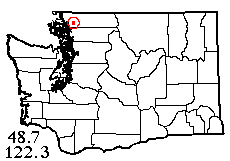 |
![]() 22 V 2018: I had some trouble finding a suitable field destination (public land, no anti-collecting rule) for the area immediately NE of Bellingham where Laurel wanted to look for the introduced Ozyptila crab spider she's studying. Finally I hit on Toad Lake, just barely into the area, a small lake 3/4 surrounded by houses but with a rather large parcel of public aquatic-access land. We arrived without incident on a pleasant sunny day, and my first concern was to sample waterside vegetation including considerable red-cedar tree foliage. I got a good number of species including one excellent record for uncommon Tetragnatha elongata. The forest had a high percentage of maple trees, so I had no trouble finding good maple litter to sift, getting a very nice 10 species of spiders plus assorted other creatures of interest. Laurel got fewer species from moss, and found one solitary spider from tapping 50 Douglas-fir cones, with her spider-of-interest apparently not present. I got a few other good species from roadside grass just outside the public land, and we both got a nice variety from fern-dominated understory. Laurel found the water-associated orbweaver Larinioides sclopetarius on the dock.
22 V 2018: I had some trouble finding a suitable field destination (public land, no anti-collecting rule) for the area immediately NE of Bellingham where Laurel wanted to look for the introduced Ozyptila crab spider she's studying. Finally I hit on Toad Lake, just barely into the area, a small lake 3/4 surrounded by houses but with a rather large parcel of public aquatic-access land. We arrived without incident on a pleasant sunny day, and my first concern was to sample waterside vegetation including considerable red-cedar tree foliage. I got a good number of species including one excellent record for uncommon Tetragnatha elongata. The forest had a high percentage of maple trees, so I had no trouble finding good maple litter to sift, getting a very nice 10 species of spiders plus assorted other creatures of interest. Laurel got fewer species from moss, and found one solitary spider from tapping 50 Douglas-fir cones, with her spider-of-interest apparently not present. I got a few other good species from roadside grass just outside the public land, and we both got a nice variety from fern-dominated understory. Laurel found the water-associated orbweaver Larinioides sclopetarius on the dock.
Now getting later in the afternoon, evidently classes had let out at nearby WWU and the secluded lakeshore was becoming more reminiscent of Bikini Beach! We hadn't found any stunning, unique habitats at Toad Lake but did get a solid sample of 34 species. On the way back to rejoin the freeway at Bellingham, we made stops for pine cones at an electrical substation and moss at a public trail by Scudder's Pond, all without finding any Ozyptila. But negative data points have their uses too!
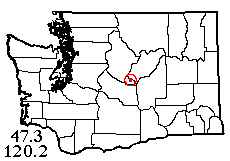 |
![]() 29 V 2018: Today's goal was to complete two partial gridspace samples from eastern Washington. Our first destination was Hydro Park just south of East Wenatchee, a narrow strip of lawns and bits of habitat between Highway 28 and the Columbia River. (An orchard project and a previous trip to Jumpoff Ridge gave us a 15-species head start). At the north end of the park, we started on the restroom building where we got Salticus scenicus and Theridion melanurum. Next, I went on a tour of waterside vegetation, such as wasn't underwater due to high reservoir level; adding 3 species. Laurel found a fence at a parking-lot edge with lots of spider niches in it, getting 5 species including seldom-seen Theridion murarium. Any leaf litter there might have been was drowned, but the flood had washed up a nice deposit of flood debris at one point before receding a bit. Sifting this gave me 3 nice species! Finally, we headed south to a point in the park where I thought I'd spotted a good pine cone deposit for Laurel on Street View. Sure enough, there it was, and tapping the cones added 2 more species. With 16 species for the site and 29 for the area, we decided to move on; but not before passing the eye-popping sight of a whole herd of yellow-bellied marmots grazing on the park lawn!
29 V 2018: Today's goal was to complete two partial gridspace samples from eastern Washington. Our first destination was Hydro Park just south of East Wenatchee, a narrow strip of lawns and bits of habitat between Highway 28 and the Columbia River. (An orchard project and a previous trip to Jumpoff Ridge gave us a 15-species head start). At the north end of the park, we started on the restroom building where we got Salticus scenicus and Theridion melanurum. Next, I went on a tour of waterside vegetation, such as wasn't underwater due to high reservoir level; adding 3 species. Laurel found a fence at a parking-lot edge with lots of spider niches in it, getting 5 species including seldom-seen Theridion murarium. Any leaf litter there might have been was drowned, but the flood had washed up a nice deposit of flood debris at one point before receding a bit. Sifting this gave me 3 nice species! Finally, we headed south to a point in the park where I thought I'd spotted a good pine cone deposit for Laurel on Street View. Sure enough, there it was, and tapping the cones added 2 more species. With 16 species for the site and 29 for the area, we decided to move on; but not before passing the eye-popping sight of a whole herd of yellow-bellied marmots grazing on the park lawn!
 |
![]() Last year, a trip to Ruby Creek got us an insufficient 17 species. Completing that was our goal for the second part of the day. We stopped near the historical marker for Blewett ghost town (also on Peshastin Creek), right beside the Blewett Pass Highway. I actually got all the needed species in 10 minutes of grass-sweeping, but we had plenty of time so we continued; I ultimately got 5 species from grass, 3 from fir foliage and one wolf spider. Meanwhile Laurel had been tapping Douglas-fir cones and added 3 more species including a really good series of the pine-cone spider Euryopis formosa. We'd been alone at the roadside turnout, but a jeep with a family including 2 or 3 kids came in and drove on down to the creekside. They and I ignored each other as I went down and foraged along the creek for leaf litter. Soon the jeep peeled out and we were alone again, but when I got up to the sifter with my litter, I found my pack had been moved, opened and rummaged (apparently nothing was missing). Somehow, one doesn't expect a family group to be thieves! Anyway, sifting got 3 nice species and we had boosted the area sample to 30, before heading for our well-earned Mountain High Hamburgers at Easton.
Last year, a trip to Ruby Creek got us an insufficient 17 species. Completing that was our goal for the second part of the day. We stopped near the historical marker for Blewett ghost town (also on Peshastin Creek), right beside the Blewett Pass Highway. I actually got all the needed species in 10 minutes of grass-sweeping, but we had plenty of time so we continued; I ultimately got 5 species from grass, 3 from fir foliage and one wolf spider. Meanwhile Laurel had been tapping Douglas-fir cones and added 3 more species including a really good series of the pine-cone spider Euryopis formosa. We'd been alone at the roadside turnout, but a jeep with a family including 2 or 3 kids came in and drove on down to the creekside. They and I ignored each other as I went down and foraged along the creek for leaf litter. Soon the jeep peeled out and we were alone again, but when I got up to the sifter with my litter, I found my pack had been moved, opened and rummaged (apparently nothing was missing). Somehow, one doesn't expect a family group to be thieves! Anyway, sifting got 3 nice species and we had boosted the area sample to 30, before heading for our well-earned Mountain High Hamburgers at Easton.
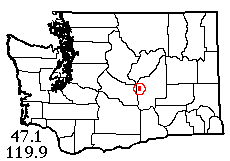 |
![]() 5 VI 2018: It seemed an ideal time for a Columbia Basin trip, so Laurel and I (with Jerry Austin this time) decided to do that hike on the John Wayne Trail through the Yakima Training Center to the ghost town of Doris. I had identified a short cut eliminating a lot of unnecessary walking, so we parked at the start of a gated road that crosses a low ridge and intersects the trail. Alas, right around the bend was a No-Trespassing sign, signed by the U.S. Army! Come to find out, though, the sign is a phoney: that tract is not army property but belongs to the BLM! Anyway, we backed off and went to the authorized trail parking area some 2.5 miles to the south, only to be confronted with a sign indicating a 3-mile hike along a shadeless, featureless road to the actual trailhead! One or more of us were so unenthused about this, we turned tail and headed for an alternate destination, Evergreen Reservoir across the Columbia River in Grant County.
5 VI 2018: It seemed an ideal time for a Columbia Basin trip, so Laurel and I (with Jerry Austin this time) decided to do that hike on the John Wayne Trail through the Yakima Training Center to the ghost town of Doris. I had identified a short cut eliminating a lot of unnecessary walking, so we parked at the start of a gated road that crosses a low ridge and intersects the trail. Alas, right around the bend was a No-Trespassing sign, signed by the U.S. Army! Come to find out, though, the sign is a phoney: that tract is not army property but belongs to the BLM! Anyway, we backed off and went to the authorized trail parking area some 2.5 miles to the south, only to be confronted with a sign indicating a 3-mile hike along a shadeless, featureless road to the actual trailhead! One or more of us were so unenthused about this, we turned tail and headed for an alternate destination, Evergreen Reservoir across the Columbia River in Grant County.
Turns out we couldn't quite drive to the reservoir ("Gate Closed Due to Vandalism"), but the walk was only a quarter-mile and there we were in a lush riparian habitat with varied trees, shrubs, grasses and flowers, within vast tracts of fairly-natural sagebrush. Plenty of spiders here (but also plenty of ticks, and a fair growth of poison ivy!). Jerry set off to turn rocks, while I swept grass and Laurel beat the lush foliage of varied riparian trees and shrubs. Laurel's beat-catch of 13 species included a probable new jumping spider as well as other rarities, plus both local species of the iridescent salticid genus Sassacus. Dictyna, which make small, conspicuous woolly webs at plant tips, were very diverse here with 6 species taken. I proceeded with several other habitats including sagebrush and leaf litter that was mixed with thorns (ouch!). Assorted fishermen and boaters came and went at this popular site. Jerry's rock-turning (mainly in riprap below the road) produced one Phidippus audax, some Dictyna calcarata, the uncommon Salticus peckhamae, and several Attulus ammophilus, the introduced salticid that I found for the first time last year right across the Columbia.
Having hit most of the available habitats at our main site, we walked around to the far side of a canal draining the reservoir in search of other habitats. Still no wolf spiders to be found, but Laurel added an adult Oxyopes from Russian-olive foliage and others from a footbridge railing while I added a few things from riparian sweeping and sagebrush, plus an unusual Xysticus on yarrow. When we left, we had 30 species from Evergreen Reservoir in a short day (39 including some old prior records from nearby Burke Lake), and had just time to reach Mountain High Hamburgers! Later on, I found 3 ticks (all female) on my body and Jerry found at least one — there had to be a catch somewhere!
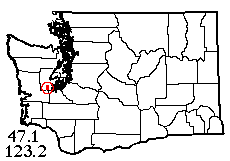 |
![]() 12 VI 2018: Fortunately the week Laurel wasn't available was also the week Jerry Austin had a vehicle, so he and I headed south, then a bit west to Lost Prairie some 8.2 miles SW of Shelton. In this region, 61,000 hectares of semi-natural open prairie existed until about 1830; since then, fire suppression has allowed forest encroachment and humans have done their full share of encroaching too, and about 8% of the original prairie remains. Up to 2012, Lost Prairie was almost entirely forested, but then Port Blakely Tree Farms clearcut-logged the trees, and now it's a prairie again — at least for a while. And I'm here to tell you, it is a simply great spider habitat! Just a little sun was filtering through the overcast, so I quickly tried to catch what wolf spiders were active: 3 species, 2 of them mature, plus one very unusual jumping spider. Then it was time to sweep the prairie field layer, apparently dominated by daisies, catsear and foxglove but with lots of native plants lurking in there too. Between us, Jerry and I swept 27 identifiable species including some great rarities like Tmarus angulatus, Metepeira grandiosa (or maybe something new), Cyclosa turbinata and about 4-5 I don't immediately recognize.
12 VI 2018: Fortunately the week Laurel wasn't available was also the week Jerry Austin had a vehicle, so he and I headed south, then a bit west to Lost Prairie some 8.2 miles SW of Shelton. In this region, 61,000 hectares of semi-natural open prairie existed until about 1830; since then, fire suppression has allowed forest encroachment and humans have done their full share of encroaching too, and about 8% of the original prairie remains. Up to 2012, Lost Prairie was almost entirely forested, but then Port Blakely Tree Farms clearcut-logged the trees, and now it's a prairie again — at least for a while. And I'm here to tell you, it is a simply great spider habitat! Just a little sun was filtering through the overcast, so I quickly tried to catch what wolf spiders were active: 3 species, 2 of them mature, plus one very unusual jumping spider. Then it was time to sweep the prairie field layer, apparently dominated by daisies, catsear and foxglove but with lots of native plants lurking in there too. Between us, Jerry and I swept 27 identifiable species including some great rarities like Tmarus angulatus, Metepeira grandiosa (or maybe something new), Cyclosa turbinata and about 4-5 I don't immediately recognize.
The young Douglas-fir foliage was productive too, 20 species adding 8 to the sweep sample. Salal added one more, and 2 good gnaphosids were under dead wood on the ground. When we moved on from the prairie site in mid-afternoon we already had 41 species!
Hoping to really maximize the catch, we then moved north to a boat-access site on Lost Lake (named for the prairie, or vice versa?) to get some of the more "regular" spiders. Jerry was petrified about parking there with no Discover Pass, but after much fussing around we finally found the Pass in the glove compartment… Here, I added 1 spider species from the outhouse, 4 from leaf litter and 3 more from a lakeshore tree grove. Moving just outside the public-access tract, we added about 10 more from ferns and moss. Just in time to stop us from overdoing it, rain started to fall. We had about 60 species from our 2 sites!
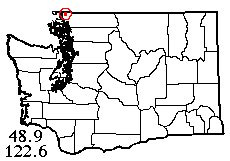 |
![]() 21 VI 2018: With Laurel back in action, we picked a destination that interested both of us, one of the Canadian-border gridspaces immediately east of previously-sampled Blaine. Not much public land here, and the best tract I could find was right next to the freeway (vroom vroom). We reached our destination without trouble, and I managed to spot the well-hidden former road to an old gravel pit, now a pond. The old road is sort of a trail, but rapidly being swallowed by blackberry, which we just managed to squeak through. Before long, I found an access to the pond shore through a tree grove that was liberally sprinkled with Douglas-fir cones. Laurel proceeded to tap these, but found no spiders! I didn't do much better with the cottonwood litter, only one mature species. So I left Laurel sifting moss while I went back to the other side of the trail and beat understory foliage at the top of a high bank. We both did much better, reaping 9 species each. And now it was time to head for the adjacent clearcut habitat.
21 VI 2018: With Laurel back in action, we picked a destination that interested both of us, one of the Canadian-border gridspaces immediately east of previously-sampled Blaine. Not much public land here, and the best tract I could find was right next to the freeway (vroom vroom). We reached our destination without trouble, and I managed to spot the well-hidden former road to an old gravel pit, now a pond. The old road is sort of a trail, but rapidly being swallowed by blackberry, which we just managed to squeak through. Before long, I found an access to the pond shore through a tree grove that was liberally sprinkled with Douglas-fir cones. Laurel proceeded to tap these, but found no spiders! I didn't do much better with the cottonwood litter, only one mature species. So I left Laurel sifting moss while I went back to the other side of the trail and beat understory foliage at the top of a high bank. We both did much better, reaping 9 species each. And now it was time to head for the adjacent clearcut habitat.
There was blackberry in the clearcut too, but it was better-hidden, lurking here and there in the lush, apparently sweepable field layer to catch my net in its horrid spiny grip. I did manage to sweep 5 species, but beating the young Dourlas-firs was more productive, 9 species including a bunch of juvenile linyphiids that seem to be the expected European sheetweb weaver Linyphia triangularis, moving down from B.C. I'll have to return for adults some time. Laurel found several leaf nests in the clearcut alder (only one inhabitant mature, jumping spider Eris militaris) and some more, less productive moss to sift. We now had 28 species.
Partly out of curiosity, we briefly visited two additional sites in the gridspace: first, the Custer Rest Area along the freeway (a long drive around but within a short stroll from where we'd just been), where we each added one house spider species to the list. Laurel was curious to see a site I'd picked along H Street Road just a half mile south of the international border, though I warned her that the black helicopters might take an interest in us; she thought I must be kidding! She parked the car and started sifting moss (which was very lush at this site) while I ducked a short distance into the trees to sift litter. When who should bob along but a Border Patrol agent, in a white car not a black helicopter, who asked Laurel a few questions but apparently decided she was innocent; I remained invisible. At this site, we each added 2 more species to the list, for a nice solid total of 34.
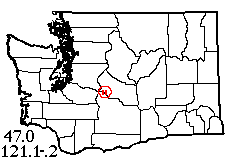 |
![]() 26 VI 2018: I had a set of 10 prior records from the Little Naches River (specimens donated from this study) that I wanted to supplement, and Chinook Pass was finally open, so that was our destination for the week. We reached Kaner Flat Campground without trouble, and as I'd hoped, it had a nice lush meadow right next to it. Also lots of Ponderosa pines with fallen cones for Laurel! Meadow sweeping produced 8 species, and foliage of young conifers 6 more. Laurel found no spiders on our campsite's outhouse, but added 2 (one of them a super-colorful Xysticus) from pine cones in the campground and 2 more from cones on the forested hillside. I got one wolf spider and sifted 2 microspiders from alder litter in a seep thicket. Just before we left, Laurel tried a second outhouse, which had a rich fauna, giving us 23 species at the site (31 with the records from the leaf-roller study).
26 VI 2018: I had a set of 10 prior records from the Little Naches River (specimens donated from this study) that I wanted to supplement, and Chinook Pass was finally open, so that was our destination for the week. We reached Kaner Flat Campground without trouble, and as I'd hoped, it had a nice lush meadow right next to it. Also lots of Ponderosa pines with fallen cones for Laurel! Meadow sweeping produced 8 species, and foliage of young conifers 6 more. Laurel found no spiders on our campsite's outhouse, but added 2 (one of them a super-colorful Xysticus) from pine cones in the campground and 2 more from cones on the forested hillside. I got one wolf spider and sifted 2 microspiders from alder litter in a seep thicket. Just before we left, Laurel tried a second outhouse, which had a rich fauna, giving us 23 species at the site (31 with the records from the leaf-roller study).
With half the afternoon left, we decided to try bagging the next gridspace westward, starting at Four Way Meadow some 4-5 miles farther up the river. Soon reached, the meadow itself was deficient in parking spots so we parked a quarter mile beyond at a bridge over the river (which forms the county line here). Laurel collected two species from the bridge and one from under riverbank cobbles, plus a mature Zelotes from Doug-fir cones and a few species from forest understory. Meanwhile, I was working on roadside verge and small glades (5 species) and conifer foliage (6-7), but the bridge vicinity was giving me diminishing returns. So I hiked back to Four Way Meadow, which turned out to be a wise move. A small section of the mostly rather sparse meadow was wetter than the rest and growing lush, dense sedge; sweeping here got me no less than 9 species. Conifer foliage here had nothing new, and sedge-alder litter (though very promising-looking) added nothing at all. And then it was time to head back to the car.
In the end, our few hours in the Four Way Meadow area got a probable total of 21, barely made it! On the whole a successful day, and there's another blank area waiting farther up that same river!
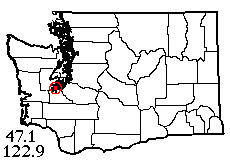 |
![]() 3 VII 2018: Laurel had a wobbly ankle and the Savela family was visiting from Finland, so we picked a closer destination with less rough walking, Burfoot Park north of Olympia which barely sticks out into the 7129 gridspace. Due to a misunderstanding, Jerry didn't realize the park straddled the gridline, but fortunately he still got a good understory sample on the right side. I headed straight for the beach, where I swept 4 species from beach meadow but found nothing active, under driftwood or in beach wrack. I did see a couple beach-ward patches of poison oak, which to judge from the overprotective warning signs should have been all over the park! Moving back into the littoral forest, I sifted leaf litter (4 species) and beat understory (11 species, to which Jerry added 5 more from a nearby site). There was little moss down at beach level, so I climbed higher (checking with the GPS that I was still on the right side of the line) to sift 6 moss-dwelling species; Laurel meanwhile got a similar sample back by the park lawn.
3 VII 2018: Laurel had a wobbly ankle and the Savela family was visiting from Finland, so we picked a closer destination with less rough walking, Burfoot Park north of Olympia which barely sticks out into the 7129 gridspace. Due to a misunderstanding, Jerry didn't realize the park straddled the gridline, but fortunately he still got a good understory sample on the right side. I headed straight for the beach, where I swept 4 species from beach meadow but found nothing active, under driftwood or in beach wrack. I did see a couple beach-ward patches of poison oak, which to judge from the overprotective warning signs should have been all over the park! Moving back into the littoral forest, I sifted leaf litter (4 species) and beat understory (11 species, to which Jerry added 5 more from a nearby site). There was little moss down at beach level, so I climbed higher (checking with the GPS that I was still on the right side of the line) to sift 6 moss-dwelling species; Laurel meanwhile got a similar sample back by the park lawn.
Meanwhile, Laurel had got nothing mature from a sample of white pine cones but some nice records from cones of the non-native black pine, fortunately just over the line. She, Markku and Jerry got a nice 6-species sample from a restroom building next to the black pine tree. I returned from my moss site, ascertained I still had an hour to spare, and zoomed back down to the beach to sample an area I hadn't been to before, adding 3 more species — one of them a Philodromus active on the beach that it took 2 guys with 2 nets to finally corral. In the end, we had a nice fill-in sample of 32 species (27 well into the beach side of the line, the rest right on the line). And it was nice to spend some time strolling on an attractive Puget Sound beach.
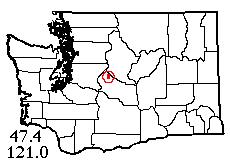 |
![]() 10 VII 2018: One disadvantage of being locked into Tuesdays for field work is that it could turn out to be the one wet day of the week! Our planned hiking spot near Snoqualmie Pass had a 30% chance of rain, but a last minute check in the morning showed it still dry, so we (Laurel, Markku and I) went for it. On arrival, it seemed the clouds had just dumped in the last hour, and everything was soaked. So, on to the backup plan, near Tacoma Pass in the south-of-the-freeway backcountry. Our directions to this site were a bit sketchy, but we finally made it over rather bumpy gravel roads. I don't know why we bothered, because it became evident well before we arrived that this site would be wet too! Since Laurel was driving, we left it to her whether to try yet another backup site, but after thinking it over, she succumbed to the lure of the unknown. Fortunately, China Point up the Cle Elum River was completely dry (though mostly cloudy) and open for business!
10 VII 2018: One disadvantage of being locked into Tuesdays for field work is that it could turn out to be the one wet day of the week! Our planned hiking spot near Snoqualmie Pass had a 30% chance of rain, but a last minute check in the morning showed it still dry, so we (Laurel, Markku and I) went for it. On arrival, it seemed the clouds had just dumped in the last hour, and everything was soaked. So, on to the backup plan, near Tacoma Pass in the south-of-the-freeway backcountry. Our directions to this site were a bit sketchy, but we finally made it over rather bumpy gravel roads. I don't know why we bothered, because it became evident well before we arrived that this site would be wet too! Since Laurel was driving, we left it to her whether to try yet another backup site, but after thinking it over, she succumbed to the lure of the unknown. Fortunately, China Point up the Cle Elum River was completely dry (though mostly cloudy) and open for business!
Time was short, so I headed directly to a pre-selected site, a small clearing on a side road, while Laurel looked around near where we'd parked the car. I soon found there wasn't much to sweep in the clearing (did got 2 good species though), so I turned to beating conifers which were present in great diversity, 7+ tree species. This eventually added 6 species. 25 white-pine cones at the crest of an adjacent low ridge added 2 more, and under log bark near the clearing I found a black gnaphosid on her egg sac. I thought she was just another Zelotes fratris which I'd just got in the pine cones, but lo, 'twas a new species of Callilepis!
Next, Markku joined me for a short hike up the Paris Creek Trail to find some small "meadows" I'd found on aerial photos. Turns out they were just treeless spots on the huckleberry understory. While I was up there, I tried some dead-wood collecting, but no dice. Back at the trailhead I found some grass to sweep around the parking lot, adding 2 species including a great Philodromus rodecki. I concluded my efforts in the ravine where the road crossed Paris Creek, where I found 2 species on the rocky sides and sifted a Micaria from moss. Meanwhile, Laurel had located a much more mesic environment farther down the creek between the road and the river, where her 6 species from conifer foliage had zero in common with the 6 I'd taken higher up. She took 3 more from understory and more white pine cones, which were all over the place. Thanks to the lack of overlap between our joint efforts, in our short visit we managed to get a sufficient 23-24 species sample, with good stuff in it too! On the way home we introduced Markku to Mountain High Hamburgers.
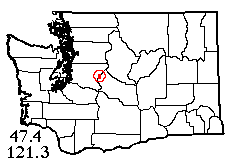 |
![]() 17 VII 2018: After last week's failure, this time we succeeded in hiking and spider-sampling Gold Creek Trail east of Snoqualmie Pass in non-rainy (indeed, decidedly on the hot side) weather. Markku joined us again, also Jerry Austin. Now, the actual trailhead for Gold Creek is over a mile north of the trail parking lot. Between is an area of privately owned cabins connected by good gravel roads. The cabin owners, it seems, don't want hikers driving past their cabins (aww... poor things), so hikers have to hike the extra mile before starting on the trail! At least there were some flowers and butterflies to view along the way. Howbeit, we finally were on the actual trail. Jerry noted a spot with gravel-bar access for a later visit, but we forged on and we all eventually made it to the large "meadow" I'd spotted from the air.
17 VII 2018: After last week's failure, this time we succeeded in hiking and spider-sampling Gold Creek Trail east of Snoqualmie Pass in non-rainy (indeed, decidedly on the hot side) weather. Markku joined us again, also Jerry Austin. Now, the actual trailhead for Gold Creek is over a mile north of the trail parking lot. Between is an area of privately owned cabins connected by good gravel roads. The cabin owners, it seems, don't want hikers driving past their cabins (aww... poor things), so hikers have to hike the extra mile before starting on the trail! At least there were some flowers and butterflies to view along the way. Howbeit, we finally were on the actual trail. Jerry noted a spot with gravel-bar access for a later visit, but we forged on and we all eventually made it to the large "meadow" I'd spotted from the air.
It's really a valley-side talus field overgrown with shrubs, herbs and alder thickets. You can't run around in it, but for spiders and butterflies I still say it counts as a meadow! Jerry headed back to his gravel bar, Markku went ahead seeking photo subjects, and Laurel went on to the next tree group for cones to beat, while I swept the meadow foliage. Out in the hot sun, sweeping didn't get me much, but as soon as I was in the meadow-edge shade I started getting spiders hand over fist, including 2 different mature Araneus orbweavers in the same sweep! Eventually I had 13 species from the sweep sample. Conifer foliage here had a few spiders but nothing different; however, sifting slide-alder litter added 4 species including a totally unfamiliar Cybaeopsis, and moss on a boulder added one more: 18 already! Meanwhile Laurel, in the next tree-group upslope, had found 3 more species from aerial webs, an unfamiliar Cybaeus under bark, and nothing at all in Douglas-fir cones (can't win them all). I had hopes for dead-wood habitat in forest just off this meadow, but it too yielded nothing.
Back in forest habitats below the meadow, I found nothing new, but Jerry got two good additions from his gravel bar site while Laurel, joining him there, added 2 more from conifers. Just south of the trailhead, but north of the private cabins, there is a separate small nature preserve around "Heli's Pond" that I'd missed on the way in. This put the icing on the cake, adding 4 species each from sweeping and conifer-beating. And Laurel found one more in the road during the long slog back to the car. In all we took 34 species, not bad at all for moderate elevation this late in the year, and some very interesting species too!
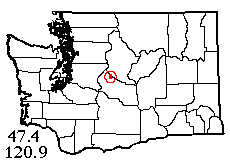 |
![]() 24 VII 2018: Seeking higher elevation sites, I made a trip plan near the extreme north end of the North Fork Teanaway River road in Kittitas County. Here I located what appeared to be a nice lush meadow near De Roux Campground. Laurel, Markku and I arrived (on another hot summer day) to find that it truly was a nice lush meadow! Reached by a short trail crossing the river (more of a creek at this point) on a well-built bridge, it was floristically rich, with drier, streamside, and wetland areas, within an apparently post-fire forest with decidedly sparse live trees. Markku wandered about photographing plants and butterflies, Laurel started collecting by the stream, and I began sweeping the meadow. It was slow going at first, but I eventually got a fine 11-species sweep sample featuring an uncommon Philodromus.
24 VII 2018: Seeking higher elevation sites, I made a trip plan near the extreme north end of the North Fork Teanaway River road in Kittitas County. Here I located what appeared to be a nice lush meadow near De Roux Campground. Laurel, Markku and I arrived (on another hot summer day) to find that it truly was a nice lush meadow! Reached by a short trail crossing the river (more of a creek at this point) on a well-built bridge, it was floristically rich, with drier, streamside, and wetland areas, within an apparently post-fire forest with decidedly sparse live trees. Markku wandered about photographing plants and butterflies, Laurel started collecting by the stream, and I began sweeping the meadow. It was slow going at first, but I eventually got a fine 11-species sweep sample featuring an uncommon Philodromus.
The wettest parts of the meadow had a nice moss layer on the ground, which I tried sifting; that was worthwhile, adding at least 3 species. I had hoped alder litter by the river would be siftable also, but it was bone dry and spiderless. Understory sweeping added one species. Although Laurel had done considerable conifer beating, I tried some also, adding 3 more species to several she'd already taken. Meanwhile, back at the campground, Laurel took the best spider of the day (an undescribed Habronattus jumping spider) from the outhouse, and beat a bunch of white-pine cones for 2 identifiable species.
With at least an hour left before we needed to start for home, we decided to explore the end of the road (around 1.5 miles beyond our main site). I'd expected a denser forest there, but no such luck; however, there was lots of under-rock habitat there, where I apparently added two species but both turned out to be juvenile. Laurel got what we thought was an adult Araneus gemmoides on the outhouse, but that also turned out to be juvenile. Oh well, we still got at least 23 species for the day, but it was clearly time to turn our attention to more mesic habitats.
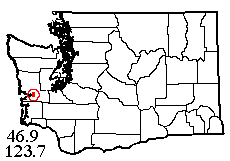 |
![]() 31 VII 2018: For the third time, we got a good sample in dry late-July by going to the ultra-moist coastal plain of Grays Harbor County. My main site this time was the Blue Slough boat launch at the edge of the Chehalis Surge Plain natural area preserve. A trail goes east from the site and marks the border of the preserve, so we could collect outside the bounds by staying on the right side of the trail! Driving independently, Markku arrived about 10 minutes after Laurel and I. I started with beating understory ferns and shrubs which, with a little grass, got me up to 12 species. Laurel brought bag after bag of moss from the trailside forest back to a handy picnic table to sift, adding 8 species. I beat spruce foliage (wearing a glove due to the sharp needles), adding 5. Salal foliage (me) and spruce cones (Laurel) added no species, but they did have spiders! I thought I was getting some really cool spiders from litter in maple crotches, but reality didn't measure up and this added only 2 species. Alder litter added no spiders but did add 3 harvestman species. Total species for Blue Slough, 29. I also encountered Marc Hayes, herpetologist friend, who came by leading a tour!
31 VII 2018: For the third time, we got a good sample in dry late-July by going to the ultra-moist coastal plain of Grays Harbor County. My main site this time was the Blue Slough boat launch at the edge of the Chehalis Surge Plain natural area preserve. A trail goes east from the site and marks the border of the preserve, so we could collect outside the bounds by staying on the right side of the trail! Driving independently, Markku arrived about 10 minutes after Laurel and I. I started with beating understory ferns and shrubs which, with a little grass, got me up to 12 species. Laurel brought bag after bag of moss from the trailside forest back to a handy picnic table to sift, adding 8 species. I beat spruce foliage (wearing a glove due to the sharp needles), adding 5. Salal foliage (me) and spruce cones (Laurel) added no species, but they did have spiders! I thought I was getting some really cool spiders from litter in maple crotches, but reality didn't measure up and this added only 2 species. Alder litter added no spiders but did add 3 harvestman species. Total species for Blue Slough, 29. I also encountered Marc Hayes, herpetologist friend, who came by leading a tour!
My planned second site, less than a mile away as the crow flies, was an upland tree farm site with dense 9-year-old Douglas-fir, and plenty of grass and herbs (and, alas, cutleaf blackberry) around the edges. Laurel swept the field foliage while I beat the trees and between us we added 11 more species for a total of 40! I was especially glad to see a nice male Neoscona arabesca in Laurel's sweep. Finally, we made a stop in the middle of Cosmopolis for some urban species. This wasn't too productive, but did add Salticus scenicus from fences and one more species from a sample of non-native pine cones Laurel tapped. So, homeward with a fine 42 species!
 |
![]() 14 VIII 2018: The plan this time was to hit subalpine habitats on an unnamed mountain NW of Illabot Peaks in the North Cascades. Illabot Creek Road was fine with just a few potholes, but the side road toward Illabot Peaks was a different story, and in less than a mile we'd encountered erosion ruts and paint-scraping alder that Laurel understandably didn't care to drive through. Hiking the remaining 2+ miles up the road would have been possible except on this day of very-smoky air when heavy breathing was inadvisable! So, rather than drive all the way back to the highway and try plan B, Laurel suggested I at least try collecting where we were (3400' elevation). Somewhat to my surprise there was dead wood habitat in the hemlock-true fir forest, and a reasonable number of spiders in it. So I kept tapping fallen bark chunks for a while, thinking I'd be lucky to get 4 species; little suspecting I actually got eight! Meanwhile, Laurel sampled from shrubs and verge along the traffic-free dirt road, actually getting 13 species including a very nice adult Araneus nordmanni. A little conifer beating added one species, with nothing different from forest understory, but we already had 22 species!
14 VIII 2018: The plan this time was to hit subalpine habitats on an unnamed mountain NW of Illabot Peaks in the North Cascades. Illabot Creek Road was fine with just a few potholes, but the side road toward Illabot Peaks was a different story, and in less than a mile we'd encountered erosion ruts and paint-scraping alder that Laurel understandably didn't care to drive through. Hiking the remaining 2+ miles up the road would have been possible except on this day of very-smoky air when heavy breathing was inadvisable! So, rather than drive all the way back to the highway and try plan B, Laurel suggested I at least try collecting where we were (3400' elevation). Somewhat to my surprise there was dead wood habitat in the hemlock-true fir forest, and a reasonable number of spiders in it. So I kept tapping fallen bark chunks for a while, thinking I'd be lucky to get 4 species; little suspecting I actually got eight! Meanwhile, Laurel sampled from shrubs and verge along the traffic-free dirt road, actually getting 13 species including a very nice adult Araneus nordmanni. A little conifer beating added one species, with nothing different from forest understory, but we already had 22 species!
So, back the way we came to supplement this unexpectedly nice mid-elevation sample with lower sites. Where the road crosses Hilt Creek I had spotted a small waterfall and we decided to stop and check it out. Upper Hilt Creek Falls was one of the best sites we could have picked, with a deeply shaded rocky gorge featuring lush understory plus moist cobbles, moss, and leaf litter. The foliage added 2 species, the alder litter added 4, and the moss added 4 more; even roadside grass and trees added 3, so we now had an amazing (for August) 36 species! We had yet to hit the low-elevation site I'd originally planned on, so we went ahead and stopped there, but extremely high dense grass effectively prevented me from reaching the trees. Even so, I added 2 species from ferns and Laurel got a nice Eris militaris on a side-road gate. I still wanted to do some more Douglas-fir beating, so we tried one last site on a side road to a tiny clearing used for illegal dumping. Here, the trees did add 2 more species and Laurel found the last 2 active in the clearing, an unseasonable Pardosa-with-eggs and seldom-seen ant mimic Castianeira longipalpa, very nice. 43 species when we'd barely expected to make 21!
Back in Darrington, the smoke from distant fires had become so thick we could look directly at the sun. Our chosen burger place didn't even have ice cream, but even this couldn't spoil such a successful day.
 |
![]() 24 VIII 2018: Laurel and I had postponed collecting in hopes of better air conditions. In 10 days, the smoke cleared enough for us to give it a try. This time we headed for Tacoma Pass (about 16 miles SSE of Snoqualmie Pass) where we'd been rained out on July 10. With us was Andrew McKenna-Foster, an incoming UW grad student with previous spider experience! The plan was to hike south on the Pacific Crest Trail from the pass to the area and elevation where I wanted to collect. A bonus: this section of the trail passes through magnificent old growth. The temperature was decidedly cool, a nice change after days of heat but I really should have packed a sweater — oh well, 'twas discomfort in a worthy cause. Anyway, I started by tapping fallen bark and dead wood chunks, aiming at 50 specimens which I eventually got. This had good diversity (10 species), but surprisingly skewed toward lowland taxa at this 4200' elevation, with only one species definitely subalpine. Laurel swept young hemlock trees in the understory, adding 5 species including Poeciloneta fructuosa which I haven't seen in a while. Laurel's sift of some rather scanty moss (with bark scales) had 6 species, including some nice ones! Perhaps most notable was subalpine Wubana suprema. Andrew wandered around experimenting with habitats and techniques new to him, but did get one species no one else did from vanilla-leaf understory. At the end, I sifted some hemlock needle litter getting 4 species, 2 of them new for the day. From this first site alone we had a minimally sufficient 22 species.
24 VIII 2018: Laurel and I had postponed collecting in hopes of better air conditions. In 10 days, the smoke cleared enough for us to give it a try. This time we headed for Tacoma Pass (about 16 miles SSE of Snoqualmie Pass) where we'd been rained out on July 10. With us was Andrew McKenna-Foster, an incoming UW grad student with previous spider experience! The plan was to hike south on the Pacific Crest Trail from the pass to the area and elevation where I wanted to collect. A bonus: this section of the trail passes through magnificent old growth. The temperature was decidedly cool, a nice change after days of heat but I really should have packed a sweater — oh well, 'twas discomfort in a worthy cause. Anyway, I started by tapping fallen bark and dead wood chunks, aiming at 50 specimens which I eventually got. This had good diversity (10 species), but surprisingly skewed toward lowland taxa at this 4200' elevation, with only one species definitely subalpine. Laurel swept young hemlock trees in the understory, adding 5 species including Poeciloneta fructuosa which I haven't seen in a while. Laurel's sift of some rather scanty moss (with bark scales) had 6 species, including some nice ones! Perhaps most notable was subalpine Wubana suprema. Andrew wandered around experimenting with habitats and techniques new to him, but did get one species no one else did from vanilla-leaf understory. At the end, I sifted some hemlock needle litter getting 4 species, 2 of them new for the day. From this first site alone we had a minimally sufficient 22 species.
Back down at 3950', the trail comes out briefly into a 1990s clearcut, where I could beat as much conifer foliage as I liked, adding 3 species while Andrew added Neriene litigiosa from a conspicuous aerial web. My second planned site was on a hikable logging road that parallels the trail to the west, curling around Tacoma Creek. Here I sifted alder litter, adding 4 species plus a nice millipede, while Laurel and Andrew sampled roadside foliage. Both of them got pretty Pityohyphantes sp. #5 (a female for Laurel, 2 males for Andrew); Laurel added 2 more and Andrew, one more. In all, 34 for the day, still excellent for the end of August.
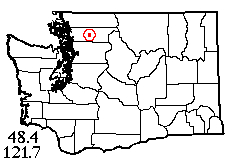 |
![]() 28 VIII 2018: It was possibly the last trip of summer, and only Laurel and I could make it. We headed for an unnamed peak in the east part of the Cultus Mountains (an outlier of the Cascades in central Skagit County), 2 miles east of Gee Point which I'd sampled in 2012. First on the agenda was a low-elevation site along Finney Creek Road at the base of the mountain, where Laurel immediately started sifting moss (added 2 species) and I swept grassy roadsides (8 species), got a nice Neriene litigiosa from a web in the forest, and beat assorted conifers (added 6). After about 1 hour, we already had 17 species, more than my running estimate. Next, we headed uphill on Road 1720 which, contrary to some reports, is in excellent shape. Parking at an overgrown, nearly-decommissioned side road, we hiked steeply upward to my planned primary site, an old growth stand at 4300' not far below the summit.
28 VIII 2018: It was possibly the last trip of summer, and only Laurel and I could make it. We headed for an unnamed peak in the east part of the Cultus Mountains (an outlier of the Cascades in central Skagit County), 2 miles east of Gee Point which I'd sampled in 2012. First on the agenda was a low-elevation site along Finney Creek Road at the base of the mountain, where Laurel immediately started sifting moss (added 2 species) and I swept grassy roadsides (8 species), got a nice Neriene litigiosa from a web in the forest, and beat assorted conifers (added 6). After about 1 hour, we already had 17 species, more than my running estimate. Next, we headed uphill on Road 1720 which, contrary to some reports, is in excellent shape. Parking at an overgrown, nearly-decommissioned side road, we hiked steeply upward to my planned primary site, an old growth stand at 4300' not far below the summit.
After last week's trip and some others, we were tempted to think of old growth as widely-spaced, giant trees where you can stroll unimpeded in any direction. Not always! Just entering this stand was a Herculean struggle up a steep bank, through an edge-foliage barrier and over logs. Once inside, tangled lower branches, logs and stumps limited our penetration to about the first 50 feet. However, it was worth all the trouble! Dead wood was abundant on the forest floor, and rich in spiders, with 12 species in the first 50 specimens. As with last week's sample, low-elevation species predominated. Laurel added 3 species from understory, and then we struggled back down to our side road, where we sampled roadside and coniferous foliage until the sun started to sink, adding only 3 more species. With the sun low, wolf spiders started to come out and we got a couple of Pardosa mackenziana, also one common gnaphosid active in the road, before calling it a day. The long drive out of the forest made us impatient for dinner, so we stopped at Darrington's Burger Barn as the sun began to set. As with our previous Burger Barn visit, there was a spider on the bathroom ceiling: this time Steatoda bipunctata.
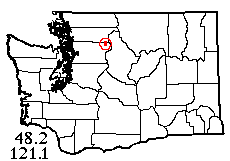 |
![]() 28 IX 2018: My schedule and Laurel's failed to mesh, so I called on alternate driver Chris Rurik for the first time on the first collecting trip of fall. Having no response from anyone else, the two of us headed north and east to the extreme end of the Suiattle River Road to collect at Sulphur Creek Campground in the heart of the Cascades. The day was a little cooler than predicted, but still fine and mostly sunny. One week into fall, some leaves were already beginning to turn. After many potholes, we arrived at the campground, closed to campers since Labor Day but still open to walk-in use, so we were able to use a nice picnic table for sifting! Leaf litter, mostly alder with some maple, was a little sparse but fairly productive with 11 spider species (only 2 of them linyphiids). Meanwhile Chris, who's interested in fungi, found plenty of variety on the forest floor. I concluded my sifting with moss on trees which only added 3 more species (sorry Laurel, no Ozyptila). Chris and I both set about sweeping understory (free of dew by this time), which was rich in spiders and added 6 more species. Invasive plants were sparse here, but there was European crab spider Phiodromus dispar and even some Asian multicolored lady beetles this far into the mountains!
28 IX 2018: My schedule and Laurel's failed to mesh, so I called on alternate driver Chris Rurik for the first time on the first collecting trip of fall. Having no response from anyone else, the two of us headed north and east to the extreme end of the Suiattle River Road to collect at Sulphur Creek Campground in the heart of the Cascades. The day was a little cooler than predicted, but still fine and mostly sunny. One week into fall, some leaves were already beginning to turn. After many potholes, we arrived at the campground, closed to campers since Labor Day but still open to walk-in use, so we were able to use a nice picnic table for sifting! Leaf litter, mostly alder with some maple, was a little sparse but fairly productive with 11 spider species (only 2 of them linyphiids). Meanwhile Chris, who's interested in fungi, found plenty of variety on the forest floor. I concluded my sifting with moss on trees which only added 3 more species (sorry Laurel, no Ozyptila). Chris and I both set about sweeping understory (free of dew by this time), which was rich in spiders and added 6 more species. Invasive plants were sparse here, but there was European crab spider Phiodromus dispar and even some Asian multicolored lady beetles this far into the mountains!
Finding not too much conifer foliage to beat in camp, we next walked up to the road where it crosses Sulphur Creek on a spider-studded bridge: 4 good species, including uncommon Zygiella dispar, from the railings. From time to time, a breeze brought down a whiff of sulfur from Sulphur Hot Springs 1 km upstream. There was just enough roadside conifer foliage, mostly hemlock and cedar, near the bridge to get a good beat sample; although rich in spiders it only added 2 species to what we'd already taken. Finally, we hiked a short distance up nearby Sulphur Creek Trail which got us into mature forest although the old growth I'd hoped for must have been farther up. It was getting on toward 6:00 (we'd spent at least 3 hours sifting) and the dim light in the forest was not too conducive to seeing tiny spiders! Nonetheless, we managed to add 2 more species from tapping forest-floor dead wood pieces, including Wubana suprema, rarest species taken. Although none of the habitats was super-productive, we got a solid sample of 30 spider species at a point about as far into the mountains as you can drive in this part of the state.
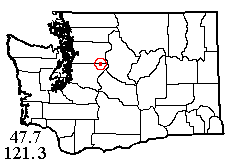 |
![]() 11 X 2018: Laurel was back in action for the first October trip, so we went to Skykomish on the South Fork Stillaguamish River in aid of her study of Ozyptila crab spider distribution in river valleys. First stop was the Skykomish Ballpark, right along the river and surrounded by good habitat. On a non-game day, the place was deserted except for spider collectors. Laurel started sifting moss while I beat some conifers and then chose a shady picnic table for sifting the abundant maple litter. Litter produced 10 species but with few linyphiid microspiders; Laurel's moss sample had more of those, but I got the only mature Ozyptila! We continued with understory and building/fence sampling, ending the site with a quite decent 32-species sample though with nothing desperately unusual.
11 X 2018: Laurel was back in action for the first October trip, so we went to Skykomish on the South Fork Stillaguamish River in aid of her study of Ozyptila crab spider distribution in river valleys. First stop was the Skykomish Ballpark, right along the river and surrounded by good habitat. On a non-game day, the place was deserted except for spider collectors. Laurel started sifting moss while I beat some conifers and then chose a shady picnic table for sifting the abundant maple litter. Litter produced 10 species but with few linyphiid microspiders; Laurel's moss sample had more of those, but I got the only mature Ozyptila! We continued with understory and building/fence sampling, ending the site with a quite decent 32-species sample though with nothing desperately unusual.
Weather was lovely and we had significant daylight left, so we proceeded to a nearby upland site, on a powerline cut through the national forest above the Beckler River. I expected a better conifer foliage sample here, but what I got was extensive grassy meadows! The grass was all dead of course, but dew-free after a sunny day and exceptionally productive! Sweeping got us 12 species, 8 of them not taken at the ballpark. The sweep sample included several of the native orbweaver Neoscona arabesca, all looking rather wizened (they would have matured in July) but this must be a great habitat for them. Beating some tiny Douglas-firs got me an Oxyopes while Laurel found a juvenile Phidippus under a rock, a mature wolf spider Tarentula kochii active on rocky substrate, and one more crab spider on the car. A final stop in the town of Skykomish got us 3 more species at the end of a street along the railroad tracks. Our excellent total, 46-47 species.
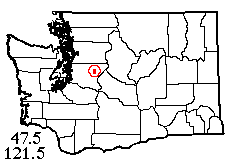 |
![]() 18 X 2018: Another 2-collector trip with Laurel to a local river valley, this time to the Middle Fork Snoqualmie River where I had a small sample from 2005 and just one record higher up. Our first stop, with the morning fog not lifted, was at the 2005 summer-collection site, to look for Ozyptila crab spiders and also get supplemental fall species. We spent our time here mostly sifting (moss for Laurel, litter for me), taking no Ozyptila but we did increase the sample from 25 to 44 species in a short time; Laurel also had a nice conversation with a local landowner who has a rock quarry up the gated road.
18 X 2018: Another 2-collector trip with Laurel to a local river valley, this time to the Middle Fork Snoqualmie River where I had a small sample from 2005 and just one record higher up. Our first stop, with the morning fog not lifted, was at the 2005 summer-collection site, to look for Ozyptila crab spiders and also get supplemental fall species. We spent our time here mostly sifting (moss for Laurel, litter for me), taking no Ozyptila but we did increase the sample from 25 to 44 species in a short time; Laurel also had a nice conversation with a local landowner who has a rock quarry up the gated road.
Our next stop and main goal was Middle Fork Campground, which oddly enough is on a tributary, the Taylor River. Here, with the sun out, we set up to sift at opposite ends of a blessed picnic table. Laurel got 16 species from moss here, but no mature Ozyptila and only 3 juveniles. My litter sift had 10 species including a pair of adult Ozyptila pacifica. Wubana pacifica were abundant here! Campground conifers, understory and the outhouse each added some characteristic species. While I finished up at the campground, Laurel hiked up the road to a bridge across scenic Taylor River, where she got at least 7 bridge-dwelling species including a nice female Araneus gemma.
Our final stop was the nearby Middle Fork Trailhead, where there was a cool suspension footbridge across the Middle Fork, leading to a trail closed for landslide danger. This bridge had the non-native A. diadematus on it, and the nearby moss yielded one juvenile Ozyptila which Laurel suspects is the introduced O. praticola. She set out some rolled-cardboard traps to make sure. In the end, we brought the 7515 gridspace up to 44 species, topped off with a gorgeous sunset. We had Mexican food instead of burgers for a change on the way home.
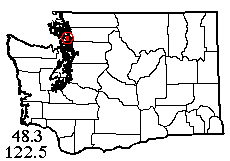 |
![]() 19 X 2018: Two all-day trips in a row, hoo boy! But I really wanted to take full advantage of the unique stretch of lovely weather. This time, Ron Austin, still working on that documentary about me, provided the transport, with brother Jerry along to help collect. For Ron's sake I picked a photogenic site, Ala Spit County Park on the east coast of Whidbey Island. Last year, friend Susan Wise-Eagle stopped here on a wet day and got only 9 species. Today, being dry except for fog and dew, I hoped to complete the sample. Arriving, we found the park fog-shrouded and the grassy field and woodland wet with dew. But I hiked out along the sandspit and found habitats mostly dry farther from shore. The farther-out, wider part of the spit featured a broad saline meadow with natural Distichlis-Salicornia, good to see, and dry enough to sweep; 5 spider species in the sample. There were also plenty of spiders under driftwood but dominated by Tegenaria agrestis, the non-native hobo spider. However, I also got Trochosa ruricola and an unknown, juvenile Philodromus, while Jerry added Calymmaria suprema and Lepthyphantes tenuis. During sun breaks, large (but not quite adult) wolf spiders were active on the beaches, probably Pardosa lowriei.
19 X 2018: Two all-day trips in a row, hoo boy! But I really wanted to take full advantage of the unique stretch of lovely weather. This time, Ron Austin, still working on that documentary about me, provided the transport, with brother Jerry along to help collect. For Ron's sake I picked a photogenic site, Ala Spit County Park on the east coast of Whidbey Island. Last year, friend Susan Wise-Eagle stopped here on a wet day and got only 9 species. Today, being dry except for fog and dew, I hoped to complete the sample. Arriving, we found the park fog-shrouded and the grassy field and woodland wet with dew. But I hiked out along the sandspit and found habitats mostly dry farther from shore. The farther-out, wider part of the spit featured a broad saline meadow with natural Distichlis-Salicornia, good to see, and dry enough to sweep; 5 spider species in the sample. There were also plenty of spiders under driftwood but dominated by Tegenaria agrestis, the non-native hobo spider. However, I also got Trochosa ruricola and an unknown, juvenile Philodromus, while Jerry added Calymmaria suprema and Lepthyphantes tenuis. During sun breaks, large (but not quite adult) wolf spiders were active on the beaches, probably Pardosa lowriei.
Back at the parking lot and base of the spit, conditions were still dewy but I was able to sift a few bags of alder litter from the woodland for another 10 species, and a little moss on alder trunks added one more. The sun having finally burned through, a section of tall beach meadow beside the parking lot was now dry enough to sweep, although the main grass field never did dry. The 5 swept species had only 1 in common with my sweep out on the sandspit. To top off the sample, I beat conifer foliage beside the access road on top of the beach bluff, not too productive but it added 3 more species. Including Susan's prior collection, we now have 30 species from Ala Spit despite the fog and dew! And it was so photogenic that it was hard to tear Ron Austin away even after I was through for the day. The adventure continues: Ron wanted to return by way of Coupeville and the Clinton ferry because he had fond memories of a Coupeville pizza place. We sailed right by Coupeville and had to backtrack, then wandered around looking for that pizzeria which, though open, had no lighted sign. However, their "all-meat" pizza certainly hit the spot.
 |
![]() 23 X 2018: For the last day of the October dry spell, Laurel consented to another far-north site, along the North Fork Nooksack River a mile east of Maple Falls. I'd picked the site because it looked so cool on aerial photos: a dirt track leading from the highway into a sort of peninsula within a river oxbow, with an apparent grassy clearing that had a giant tree in the middle. I imagined it being the setting for mysterious pagan rituals, just in time for Halloween. But on exploring the place, it was mostly natural with some evidence of athletic activity and barbecue! No sign of who owns it and no shotgun-totin' farmers on site, so we set up to collect in near-ideal weather.
23 X 2018: For the last day of the October dry spell, Laurel consented to another far-north site, along the North Fork Nooksack River a mile east of Maple Falls. I'd picked the site because it looked so cool on aerial photos: a dirt track leading from the highway into a sort of peninsula within a river oxbow, with an apparent grassy clearing that had a giant tree in the middle. I imagined it being the setting for mysterious pagan rituals, just in time for Halloween. But on exploring the place, it was mostly natural with some evidence of athletic activity and barbecue! No sign of who owns it and no shotgun-totin' farmers on site, so we set up to collect in near-ideal weather.
Laurel started sifting moss by the highway, while I wandered grassy tracks among fields and woodland with few invasive plants. Conifer foliage spiders were sparse but diverse enough with 9 species. Two invasive species, Philodromus dispar and Metellina segmentata, dominated the understory. I sifted 10 species from leaf litter after finally finding some not overrun with ants. Laurel's moss sifting from 2 different areas brought the species total to 32; she was pleased to find several adult Ozyptila pacifica of both sexes. Sweeping the grassy fields added 6 more including Ceraticelus fissiceps, and in the lowest field, set up with an apparent obstacle course, we found Castianeira longipalpa under boards. Great place!
Leaving our main site, we collected around some unoccupied buildings in Maple Falls, for a grand total of 42. The dry spell ended and rains began just as we were leaving our dinner stop outside Bellingham.
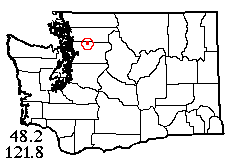 |
![]() 8 XI 2018: For her last field trip before departing on a long journey, Laurel wanted to advance her study of Ozyptila crab spiders in river valleys, so we headed for the North Fork Stillaguamish on a day supposed to be in the low 50s, temperature-wise. Arriving at our first stop, what should we meet but frost! The site, at a bridge 7+ miles NE of Arlington, didn't offer much habitat access, but Laurel got some moss to sift by sneaking under the bridge to a private tract on the far side. Despite the cold, she managed to sift 12 spider species, 8 of them new to the gridspace (bringing that to 40), but no Ozyptila! Two miles farther we made a brief roadside stop so I could add species to my anemic 22-species sample from a March 2015 trip. And then we were at the main site, a pleasant stretch of the Whitehorse Trail 3 miles east of Oso, near Montague Creek.
8 XI 2018: For her last field trip before departing on a long journey, Laurel wanted to advance her study of Ozyptila crab spiders in river valleys, so we headed for the North Fork Stillaguamish on a day supposed to be in the low 50s, temperature-wise. Arriving at our first stop, what should we meet but frost! The site, at a bridge 7+ miles NE of Arlington, didn't offer much habitat access, but Laurel got some moss to sift by sneaking under the bridge to a private tract on the far side. Despite the cold, she managed to sift 12 spider species, 8 of them new to the gridspace (bringing that to 40), but no Ozyptila! Two miles farther we made a brief roadside stop so I could add species to my anemic 22-species sample from a March 2015 trip. And then we were at the main site, a pleasant stretch of the Whitehorse Trail 3 miles east of Oso, near Montague Creek.
Feeling somewhat warmer in the sun, we hiked half a mile, passing extensive privately owned grass fields, to a county-owned tract along the river where nice habitats existed in some variety (if you could get to them through the blackberries!). Laurel got set for moss-sifting while I beat conifers (9 species), broom (4 species) and ferns (1 species) — most ferns being inaccessible. Judging it had warmed enough for litter sifting, I got some from a large maple at the top of the riverbank and got a quite nice 13 species, while Laurel was getting 11 from moss. Now Laurel headed back to the car (she wanted to try a bridge on C Post Road farther east) while I finished sifting. With 2 loads of litter left, sifting abruptly ended at 3:45 when the temperature sank below spider activity point! I figured the grass was as dry as it was going to get, so I did some sweeping (5 species) and headed back for our rendezvous. My chemical handwarmer had restored my digits to life when Laurel returned bearing 4 more species from C Post Road. Total for this area, 33 species, last sample on the Whitehorse Trail.
Despite being a bit busy, it's been a great field year!
This page last updated 21 March, 2025